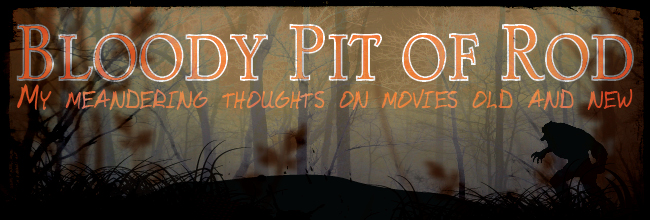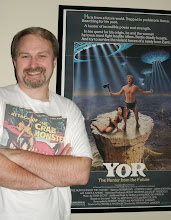In the waning days of World War II the still-beating heart of the legendary Frankenstein Monster is removed from a secret German laboratory and sent to Japan by submarine. Scientists there intend to use this amazing indestructible muscle to create soldiers that will be impervious to bullets. But mere hours after the heart arrives in Hiroshima — on August 6th, 1945 — the building housing it as well as most of the surrounding city are destroyed by the first atomic bomb blast.
Cut to 15 years later... Dr. James Bowen (Nick Adams, Invasion of Astro-Monster) is a visiting American medical researcher working at the Hiroshima International Institute of Radiotherapentics. He and his colleagues are attempting to use the horrible discoveries made about the effects of radiation to find and improve medical treatments. The benevolent scientists are unaware that, nearby, a strange deformed boy skulks in the shadows, living off whatever food he can scrounge from the garbage. Pretty Dr. Sueko Togami (Kumi Mizuno) spots the boy one night on her way home and then she and Dr. Bowen observe him from her apartment balcony a few days later. They toss the silent child some food and hope for the best. But when they encounter him again days later near the beach they realize something must be done for him. Dr. Togami is able to calm and comfort the boy so he is brought back to the Institute for tests.
Shocked to find that the gangly teenager appears to be Caucasian, the team of researchers are even more surprised to find that he has a very high resistance to radiation. Also it seems that a steady diet of nutritious food is causing an odd growth spurt and within a few days he has expanded to 10 feet in height, requiring the doctors to house him in a nearby warehouse. Out of fear a cell is constructed and chains placed on his wrists.
Working on information provided by the captain of the wartime sub that transported the Frankenstein heart, Bowen and Dr. Yuzo Kawaji (Tadao Takashima) travel to Germany and speak with the aged scientist responsible for preserving the organ. He tells his incredulous questioners that if they think the boy is somehow related to the heart the best test is to remove an arm or leg and see if it grows back. Appalled by the suggestion but at a loss for another test the two men return to Japan just as the now 15-foot tall boy escapes his confinement, leaving behind a severed hand. When the grotesque hand remains animated they know that somehow the Frankenstein heart — caught in the atomic blast — grew an entire human body around itself! Now they must somehow capture the boy in hopes of using his amazing biological properties for the betterment of mankind. This already difficult task becomes even harder when at the same time a giant beast burrows up from the depths of the earth and begins rampaging across outlying areas of the country. Soon sightings of the frightened "Frankenstein" are being mixed up with the attacks of the reptilian animal and the military are simply trying to destroy the still-growing boy. But soon enough the two oversized creatures meet and it's a fight to the death.
Absolutely one of the most entertaining Daikaiju Eiga ever produced, this bizarre amalgam of East and West is one of my favorites of the genre. The first co-production between Toho Studio and Henry Saperstein, it was imagined as a way to make the giant monster films even more profitable in the States. As shot by the legendary director Ishirô (Godzilla) Honda the whole film feels like a Japanese updating of the classic horror films of the 1930s and '40s. From the opening scenes of a snowy battle-scarred graveyard in Germany, the film makes its debt to the classic Universal Frankenstein films front and center. The slow pan across that dark cemetery looks like it could have been shot on the sets used for the 1931 movie or its sequels and sets the tone beautifully. The nearly silent sequence in which soldiers remove the heart from the mad German scientist's lab is brilliantly played and is guaranteed to put a smile on the face of any Monster Kid. The rebirth of the Frankenstein monster in a new place and time is a wonderful idea, with the usual preaching about the horrific effects of the Atom Bomb being nicely worked into origin of this new creature. I'm not sure what it says that the reborn Frankenstein monster ends up fighting to protect his new homeland, but it at the very least speaks of a wish to pull together against mutual enemies. The movie is beautiful to look at, especially in its intended widescreen format. Honda makes wonderful use of the entire frame to give real size and scope to the action and constantly providing some gorgeous images even in simple shots of the Japanese countryside. The expert miniatures and mostly well-done process shots are amazing in their detail even when too much time on screen shows the strings behind the tricks. The one complaint I've always had about this fun movie still holds true though... Why didn't they get an actual Caucasian boy to play the Frankenstein creature? One of the things that point the scientists toward the eventually solution of his nature is that he is supposedly not a Japanese child. But the young man in the role is so obviously Asian that calling him anything else is slightly silly. Of course I'm willing to overlook this as I watch the film over and over again — it's not a deal breaker — but it does make me laugh. And this IS the kind of movie in which men wear a tie as they search through a dense jungle for a giant monster. Always dress well and never let them see you sweat, I guess.
Fans of this movie can breathe a sigh of relief after years of waiting because the Media Blasters/Tokyo Shock's two-DVD presentation is everything you could want and then some! Not only do you get the original full-length Japanese version and the "International" cut (which has an added battle sequence before the end credits), you also get the American version as well, complete with English-language dub. All three versions of the film are in the correct widescreen aspect ratio and enhanced for 16x9 TVs; both the English and Japanese soundtracks are available in the original mono or in a new 5.1 Surround mix.
The first real extra of the set is the "International" cut of the film (Frankenstein vs. Baragon), which includes the giant octopus scene eliminated from the other versions. Originally added because the American producers wanted Frankenstein to fight a second monster, it was removed when the creature was deemed too unrealistic. Personally I prefer the film with this scene, as it provides a much more satisfying ending even if the sudden appearance of a giant octopus is hysterical. Other extras include a commentary track with photographer Sadamasa Arikawa, discussing his memories of working on the movie; a gallery of behind-the-scenes photos and promotional art; the Japanese trailer and an interesting teaser for the movie as well. The excised octopus scene is included on the second disc (along with the American cut) as a deleted scene, so even fans fond of the version from their childhood can see what they missed. This DVD release will do just fine.....until the inevitable Blu-Ray, of course.









.jpg)


3 comments:
Does this mean we'll get another article to read of your thoughts on the sequel?
I haven't yet seen the sequel! Sad, I know.
You should check it out. Although it's only a sequel in passing, War of the Gargantuas is a blast, easily attainable, and has another giant octopus.
Post a Comment